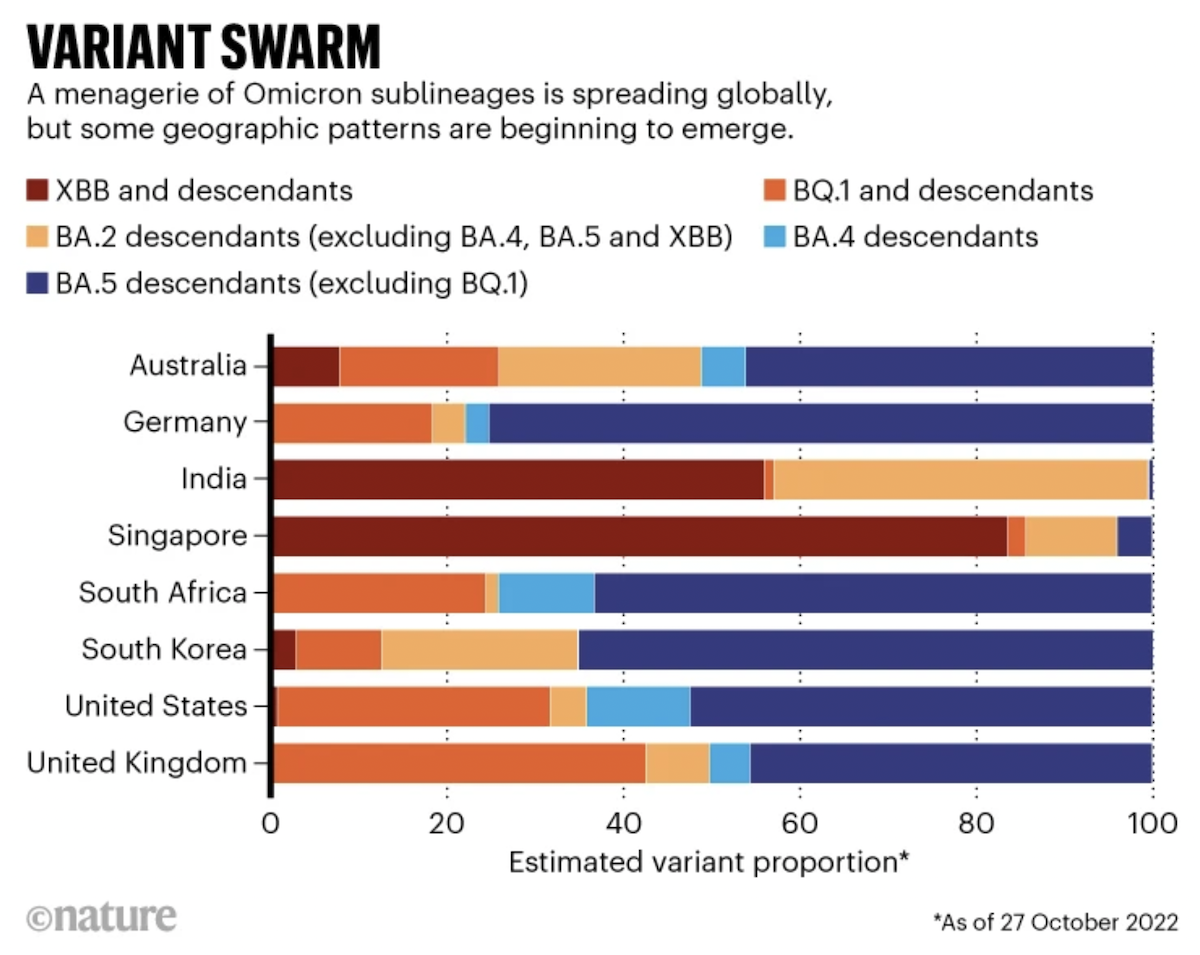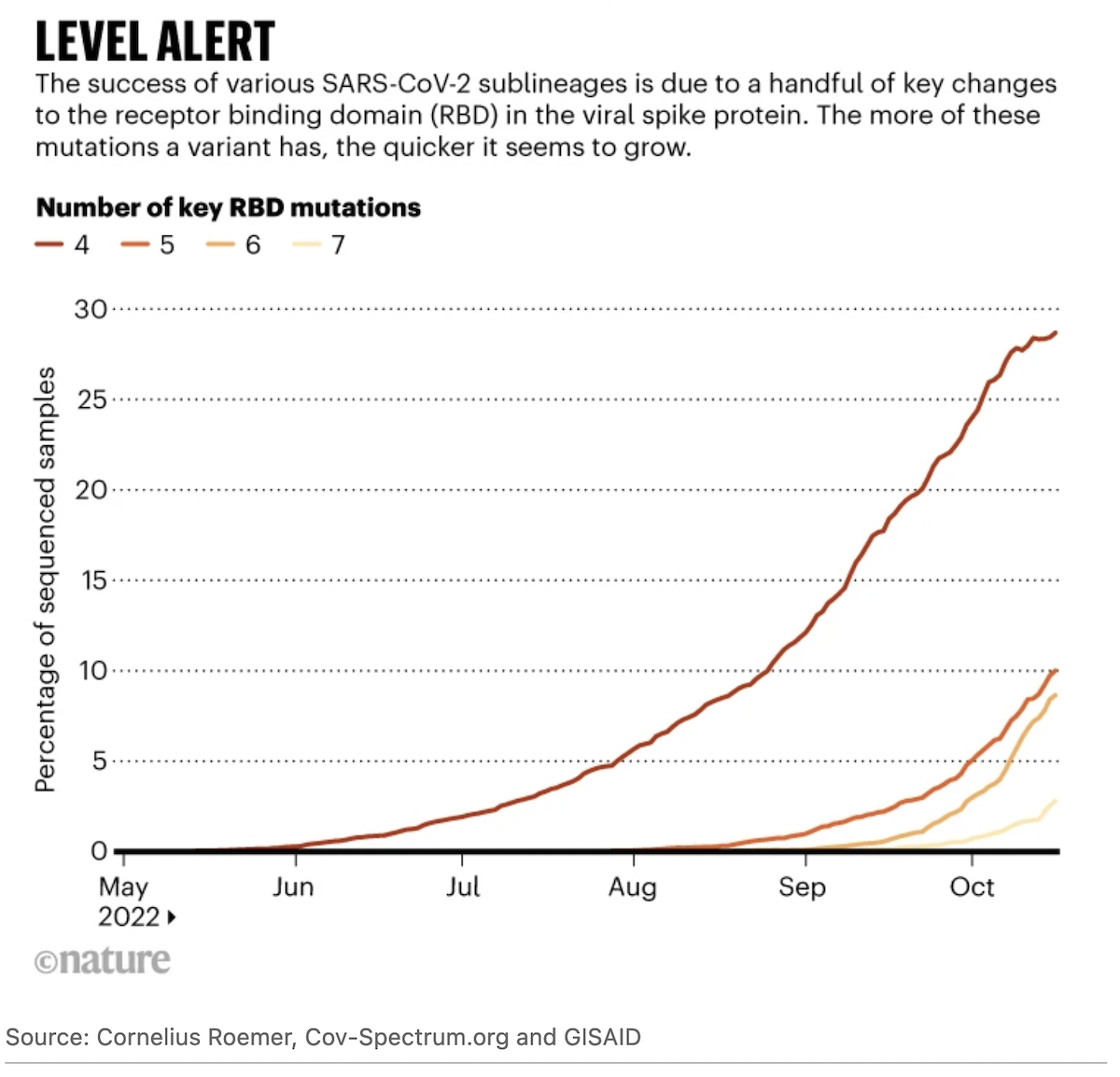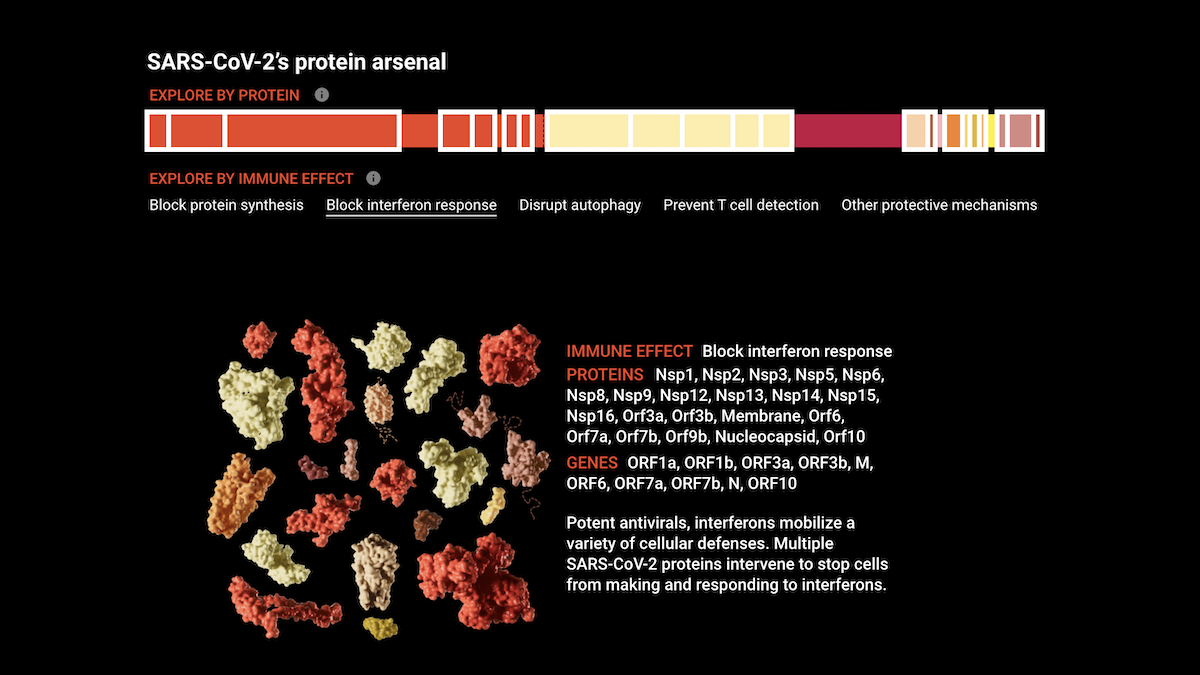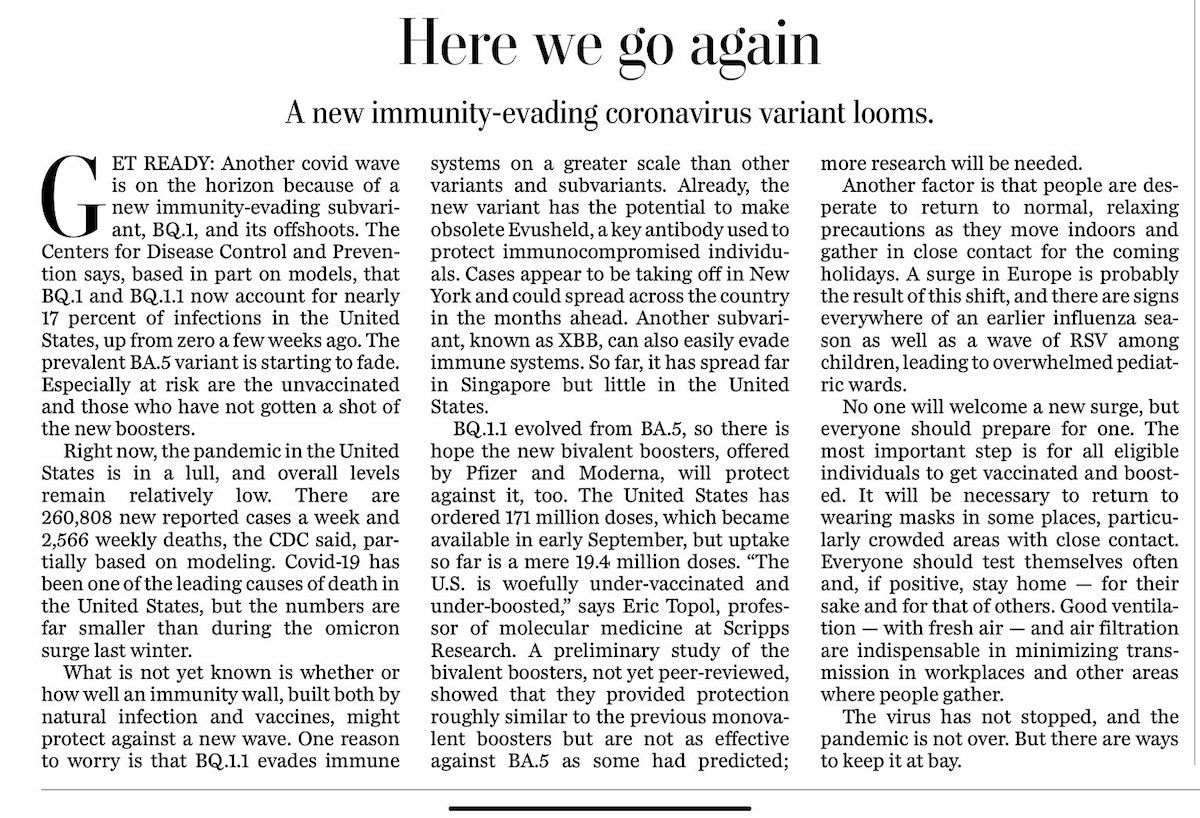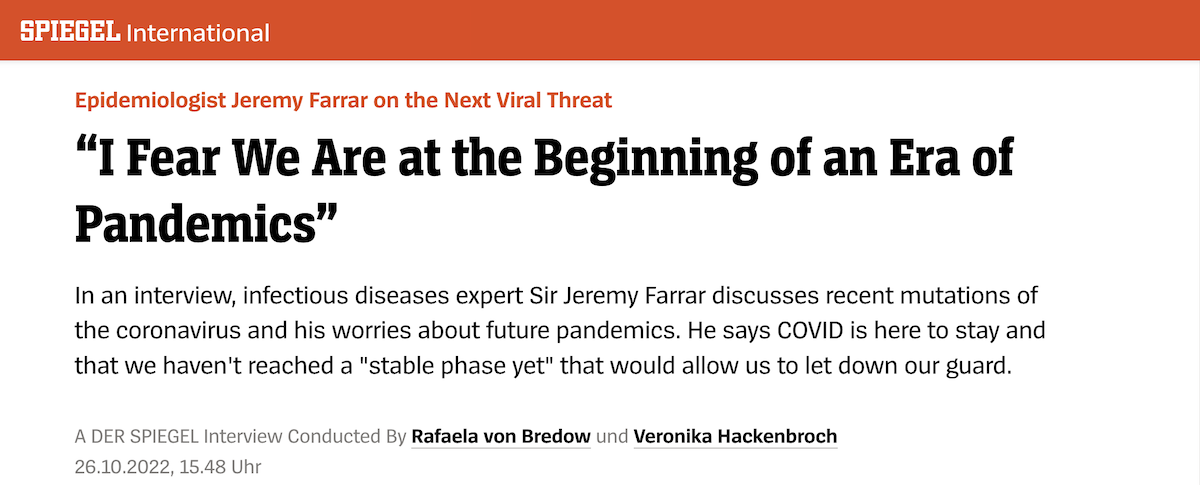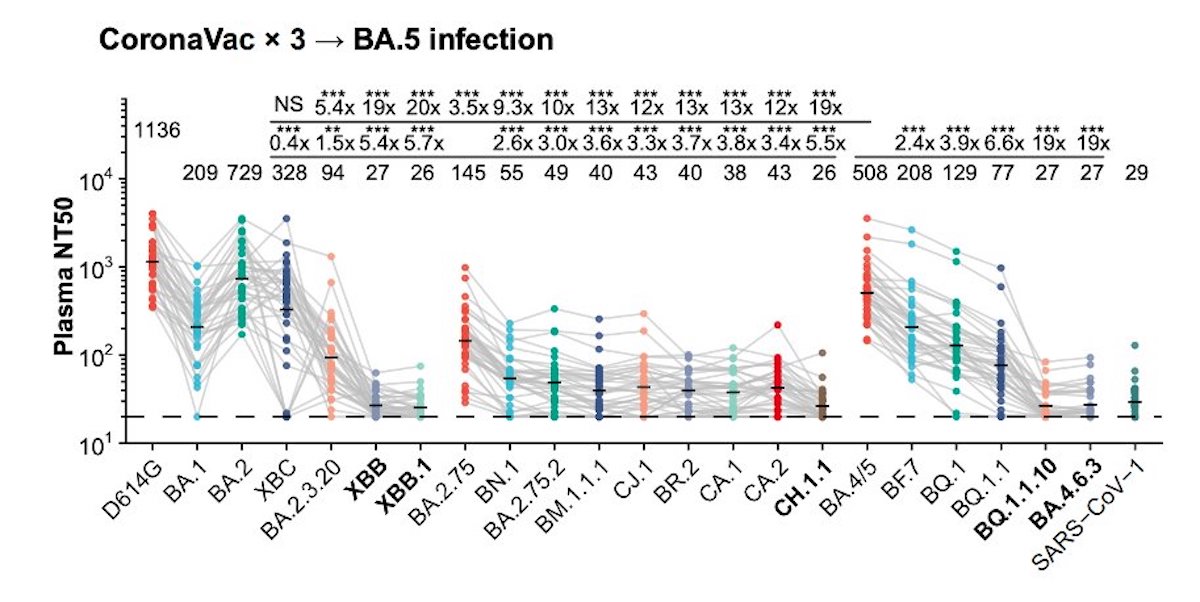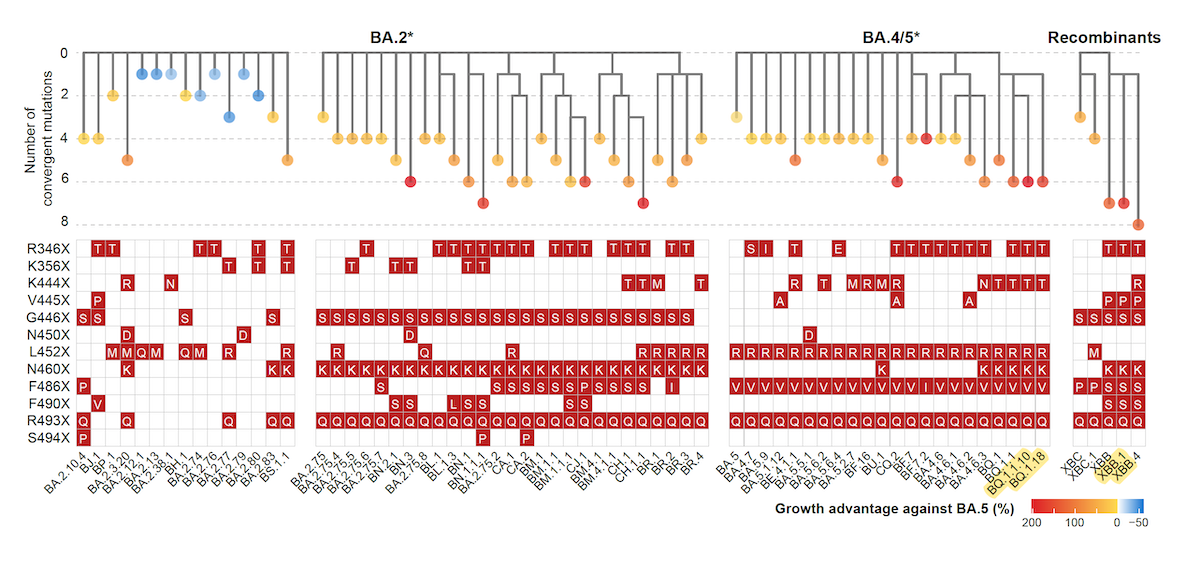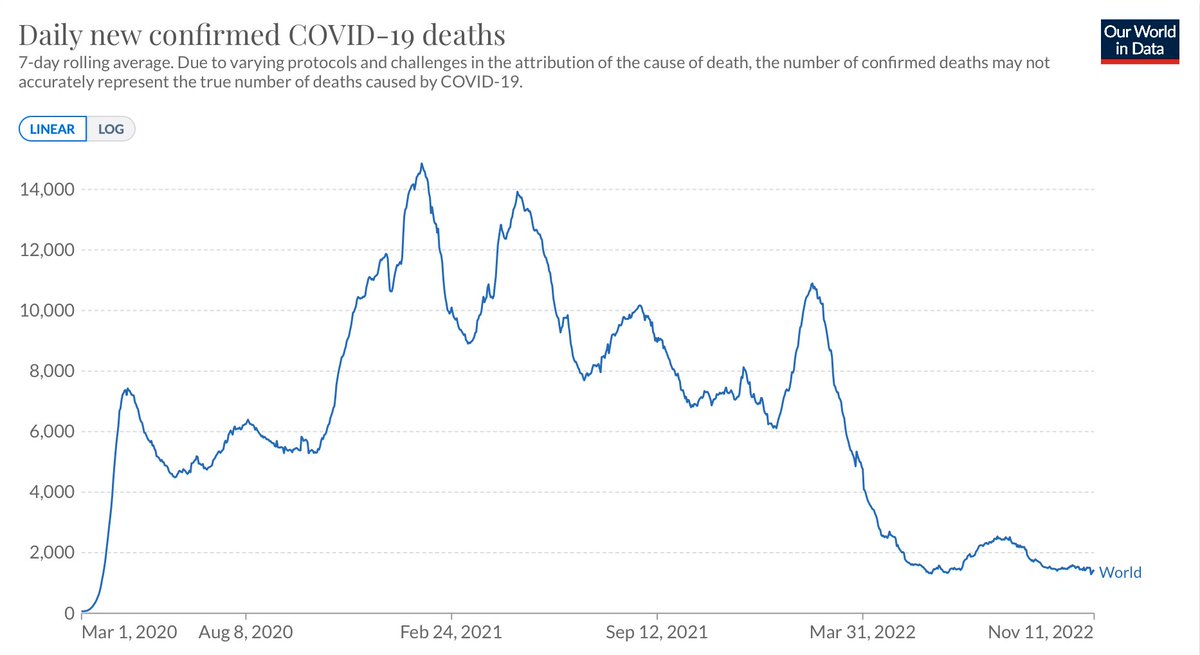5 minutes (overview).
Why are more infections of SARS-CoV-2 variants of concern dangerous?
-
SARS-CoV-2 variants can become less deadly, or more deadly, over time. Viral evolution occurs entirely by random chance.
-
SARS-CoV-2 variants immune escape is clearly occuring now, under pressure from natural and vaccine induced immunity.
-
SARS-CoV-2 variants could mutate and recombine with other co-infected variants into unknown and unpredictable outcomes.
-
SARS-CoV-2 variants can cause the debilitating and currently untreatable condition known as ‘Long Covid’ in patients at any age.
-
SARS-CoV-2 variants can be very dangerous for immunocompromised people, in pregnancy complications and in the elderly.
- SARS-CoV-2 variants XBB and BQ.1.1 now escape all approved monoclonal antibody life-saving treatments and it is probably just a question of time before viral resistance occurs to the only current effective and life-saving pill treatment, Paxlovid, by Pfizer.
Case Fatality Rate (CFR) of Severe Acute Respiratory Syndrome (SARS) and Middle East Respiratory Syndrome (MERS) coronavirus infection can be very deadly:
-
CFR of SARS-CoV-2 coronavirus (2020-21) was about 1%. BMJ Review
-
CFR of SARS-CoV-1 coronavirus (2002-03) was about 15%. CIDRAP
-
CFR of MERS-CoV coronavirus (2012-22) was about 35%. WHO
Extreme cost of the COVID-19 pandemic:
-
22 Million Lives Lost. The Economist
-
100 Million People Disabled by Long Covid. BMJ
-
$28 Trillion Dollars Lost. IMF
Lives Saved by SARS-CoV-2 vaccines:
-
20 Million Lives Saved by Vaccines in first year. The Lancet
COVID ‘variant soup’ is making winter surges hard to predict Descendants of Omicron are proliferating worldwide — and the same mutations are coming up again and again. – NEWS 28 October 2022 – NATURE doi: https://doi.org/10.1038/d41586-022-03445-6
- Some call it a swarm of variants — others refer to it as variant soup. Whatever it’s called, the current crop of immunity-dodging offshoots of the Omicron variant of SARS-CoV-2 is unprecedented in its diversity. This complexity makes it harder to predict coming waves of infection. It might even lead to a ‘double wave’ in some places, as first one variant and then another overtakes a population. But amid the chaos, patterns are emerging. The swarm has helped scientists to pinpoint a handful of immunity-evading mutations that power a variant’s spread. Globally, a few heavyweight variants have emerged, yielding different outcomes in different regions — at least, so far. In Europe, North America and Africa, the prevalence of Omicron offshoots in the BQ.1 family is rising quickly, even as overall cases seem to fall. In Asian countries including Singapore, Bangladesh and India, a lineage called XBB has already set off fresh waves of infection. Scientists are closely watching several regions where both are circulating, to see which has the edge. “In the end, probably, some variants are going to dominate, but it’s less decisive than it was in the past,” says Cornelius Roemer, a computational biologist at the University of Basel in Switzerland.
- One big family. The variants that have driven past waves, such as Alpha and Delta, all arose from distinct branches of the SARS-CoV-2 family tree. But since Omicron emerged in late 2021, it has spawned a series of subvariants, including BA.2 and BA.5, that have sparked global waves of infection. Many countries put their BA.5-led surges in the rear-view mirror in mid-2022, but most scientists thought it was only a matter of time before another sublineage came to the fore. For the past few months, variant trackers have been combing through global SARS-CoV-2 sequencing data to identify candidates. But instead of one or two fast-rising lineages, they have identified more than a dozen to watch.
- “It’s a collection or swarm or soup of variants together — not as we have seen before,” says Yunlong Richard Cao, an immunologist at Peking University in Beijing, whose team has been studying the variants’ immune-evading capacities. The members of the swarm come from various parts of the Omicron family tree. But their rise seems to be due to a handful of shared genetic mutations, most of which lead to amino acid changes in a portion of the viral spike protein called the receptor binding domain (RBD). This part of the protein is required to infect cells, and is the target of antibodies that deliver a potent immune response. Work from Cao’s team this month1 suggests that the RBD mutations help the virus to evade infection-blocking ‘neutralizing’ antibodies that were triggered by COVID-19 vaccines and infection with earlier Omicron offshoots, including BA.2 and BA.5. (That work has not yet been peer reviewed.)
- Ringing the changes. Roemer and others have observed that the more of these RBD changes a variant possesses, the faster it seems to grow, as measured by the number of sequences reported to global databases. For instance, variants, such as BQ.1,with five key RBD changes (relative to BA.2) seem to be growing in number at a slower rate than variants with six changes. A descendant of BQ.1 called BQ.1.1 has six such changes, and is rising rapidly across Europe, North America and other places. A seventh RBD change seems to lead to still swifter growth (although scientists caution that the estimates are approximate, particularly when the number of sequences recorded is small). The main ‘level 7’ variant scientists are tracking is XBB. The sub-lineage is a hybrid, or recombinant, of two Omicron sublineages, both descendants of BA.2. Of the swarm, BQ.1.1 and XBB seem to be rising to the top. The BQ.1 family is already dominant in France and is likely to drive infection waves across Europe and North America as these regions enter winter. It is also a common ingredient of the variant soup in South Africa, Nigeria and elsewhere in Africa. XBB, by contrast, looks likely to dominate infections in Asia, where it recently drove a wave of infections in Singapore.
Continuous Evolution of Omicron Variants Toward Immune Escape
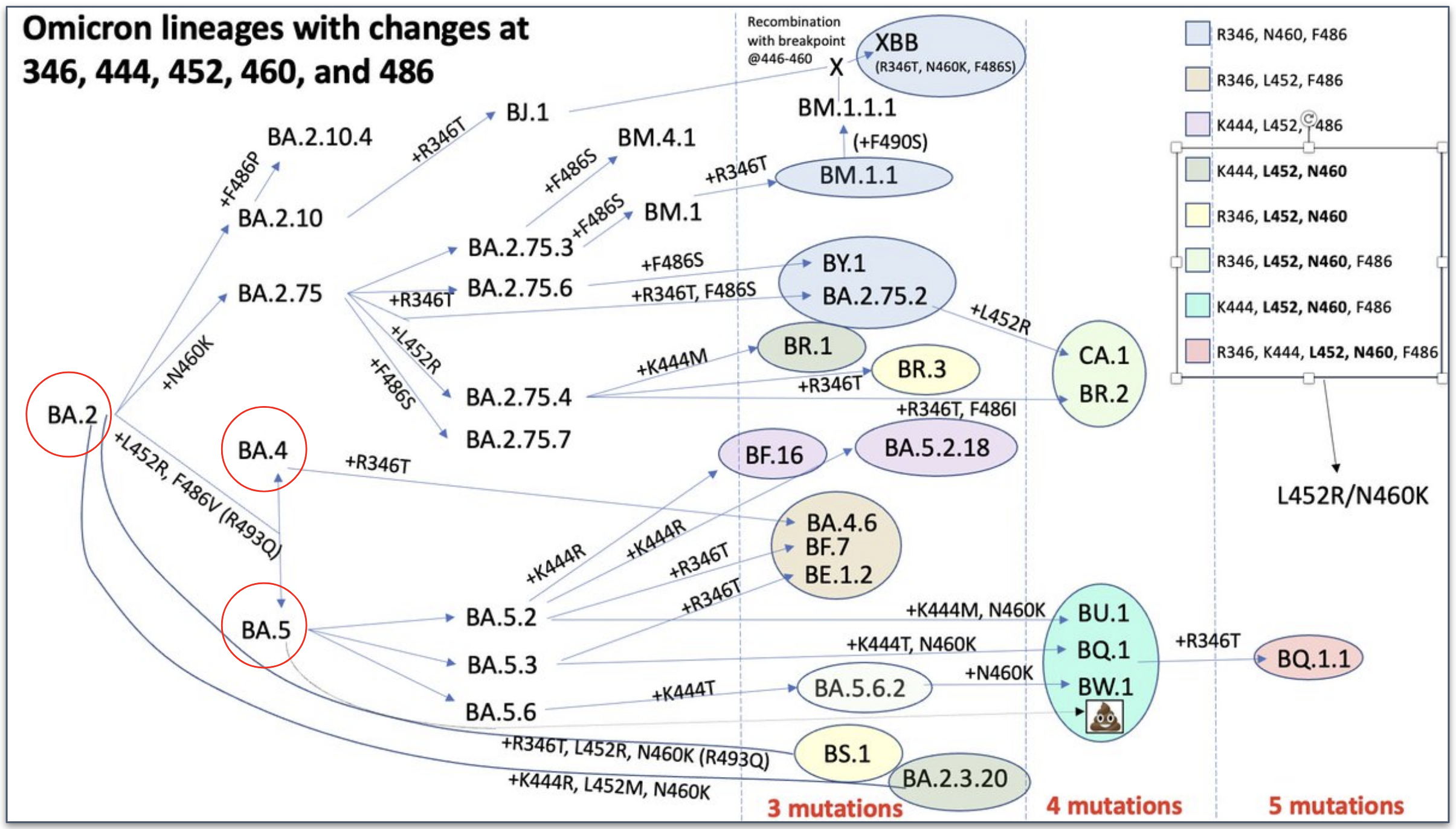
Updated 24.10.22
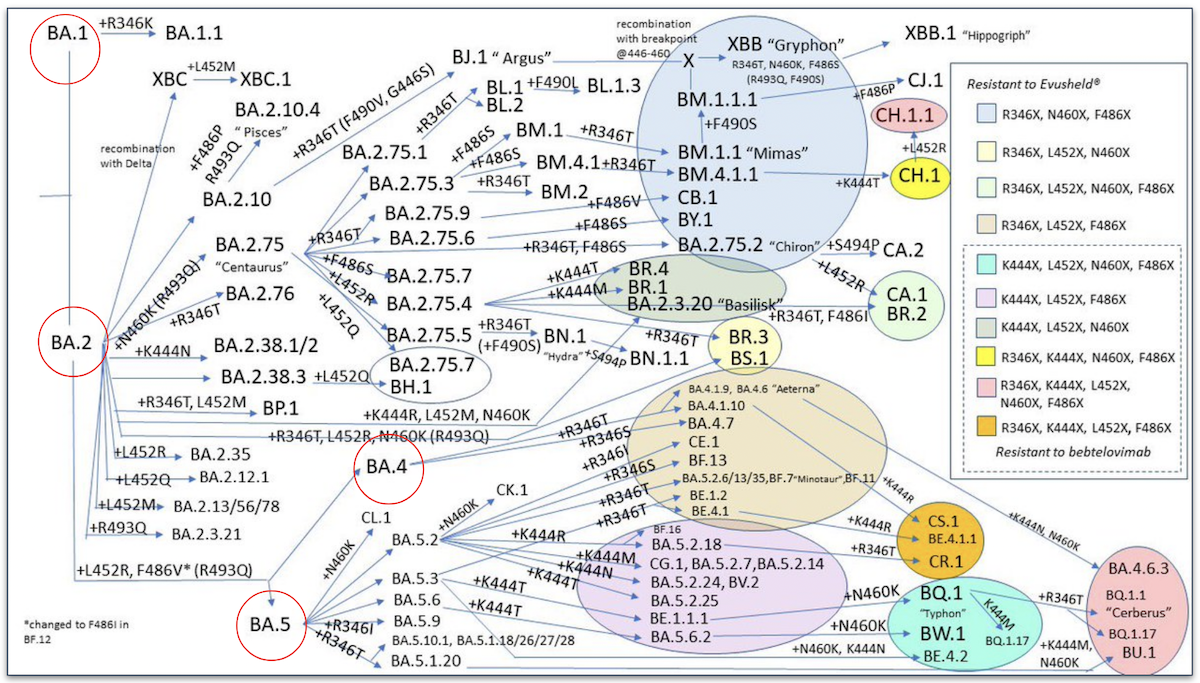
Source: Dr. Eric Topol
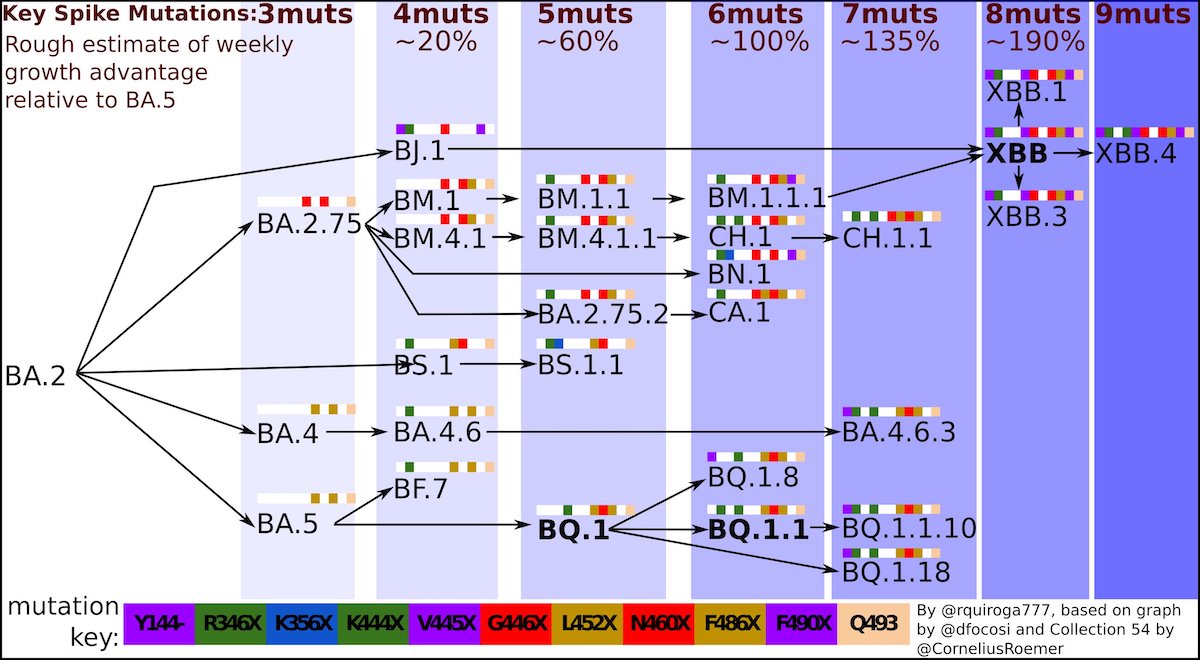
Source: Dr. Eric Topol
It’s not over, yet.
The COVID-19 pandemic continues to be a public health risk because of the rapid and uncontrollable global evolution of the SARS-CoV-2 coronavirus.
Washington Post. October 18, 2022. XBB, BQ.1.1, BA.2.75.2 — a variant swarm could fuel a winter surge.
- Instead of a single new Greek letter variant, a group of immune-evading omicron spinoffs are popping up all over the world
- Much of the world’s population has gained a measure of immunity because of vaccinations and infections with omicron. That protection gave us the relative freedoms of the moment — with many people returning to normal life. But protection is fleeting for two key reasons: immunity wanes and the virus is changing.
- “It is this constant evolutionary arms race we’re having with this virus,” said Jonathan Abraham, an assistant professor of microbiology at Harvard Medical School.
- The pace of evolution is so fast that many scientists depend on Twitter to keep up. A month ago, scientists were worried about BA.2.75, a variant that took off in South Asia and spawned a cloud of other concerning sublineages. In the United States, BA.4.6 and BF.7 have been slowly picking up steam. A few weeks ago, BQ.1.1 started to steal the spotlight — and still looks like a contender to take over this fall in Europe and North America. A lineage called XBB looms on the sidelines, and threatens to scramble the forecast.
Fortune. October 15, 2022. BQ.1.1 is among the most immune-evasive COVID variants yet. It’s coming in hot in the U.S.
- Omicron spawn BQ.1 and its offspring—the highly immune-evasive BQ.1.1—are coming in hot in the U.S. The duo comprises more than 11% of COVID cases, according to updated projections released Friday by the U.S. Centers for Disease Control and Prevention.
- “When you get variants like that, you look at what their rate of increase is as a relative proportion of the variants, and this has a pretty troublesome doubling time,” Dr. Anthony Fauci, the nation’s top infectious disease expert and the president’s chief medical adviser, told CBS News on Friday.
- Along with XBB—a combination of two Omicron strains spiking in Singapore and Bangladesh—BQ.1.1 is thought to be the most immune-evasive new variant, according to Dr. Eric Topol, a professor of molecular medicine at Scripps Research and founder and director of the Scripps Research Translational Institute. BQ.1.1’s extreme immune evasiveness “sets it up to be the principal driver of the next U.S. wave in the weeks ahead,” Topol tweeted Friday.
- On Thursday, he told Fortune that scientists won’t know to what extent it challenges vaccines, if it does, until it reaches 30%-50% of cases somewhere. “It’s not going to wipe out vaccine efficacy, but it could but a dent in protection against hospitalizations and death,” he said.
STAT. Sept. 6, 2022. White House signals most people will only need annual Covid booster.
- “It is becoming increasingly clear, that looking forward with the Covid-19 pandemic, in the absence of a dramatically different variant, we likely are moving towards a path with a vaccination cadence similar to that of the annual influenza vaccine, with annual updated Covid-19 shots matched to the currently circulating strains for most of the population,” Anthony Fauci, the country’s top infectious disease official, said at the briefing.
CIDRAP – Center for Infectious Disease Research and Policy. Dr. Osterholm on Variants
- “we still haven’t figured out immune evasion”
- Coronavirus Vaccines R&D Roadmap (CVR)
- A research and development (R&D) roadmap for broadly protective coronavirus vaccines: Setting a path to address coronavirus threats
- 1. The persistent threat of coronaviruses. The emergence and spread of three pathogenic coronaviruses over the last 20 years serves as a dire warning for the future and must galvanize the global scientific and public health communities to act now to prepare for the next coronavirus threat. We need to acknowledge that the COVID-19 pandemic is not a “black swan” event and that future spillovers of coronaviruses from animal reservoirs to humans are very likely to occur; the question is not “if” but “when.” The first novel coronavirus (severe acute respiratory syndrome coronavirus [SARS-CoV-1]) emerged in 2003 and was followed by Middle East respiratory syndrome coronavirus (MERS-CoV) in 2012. The current COVID-19 pandemic and the rapid, ongoing evolution and emergence of new SARS-CoV-2 variants of concern (VOCs) that are capable of evading immune protection present a crucial opportunity for action and highlight the need to improve global pandemic preparedness, particularly through the development of new and improved vaccines before the next coronavirus threat appears.
Pfizer eyes four-fold price hike for COVID vaccine in private US market – OCT 21 2022 – FiercePharma
- Pfizer revealed during an investor call that it is considering charging a private-market price between $110 and $130 per dose for its COVID shot Comirnaty, which was co-developed by BioNTech.
- The price is not out of line with other vaccines that are provided to adults. It is more than what CVS, for example, charges for a flu shot ($50 or $95), but is less than many other vaccines including Pneumovax 23 ($141), hepatitis ($145), meningitis ($179), shingles ($205) and HPV ($261).
Variant Fold Evasion ranking of antibody neutralisation drop. Testing is with ≈ 14,000 pooled US donors from April 2022. Details as per figure 6J here: Nature
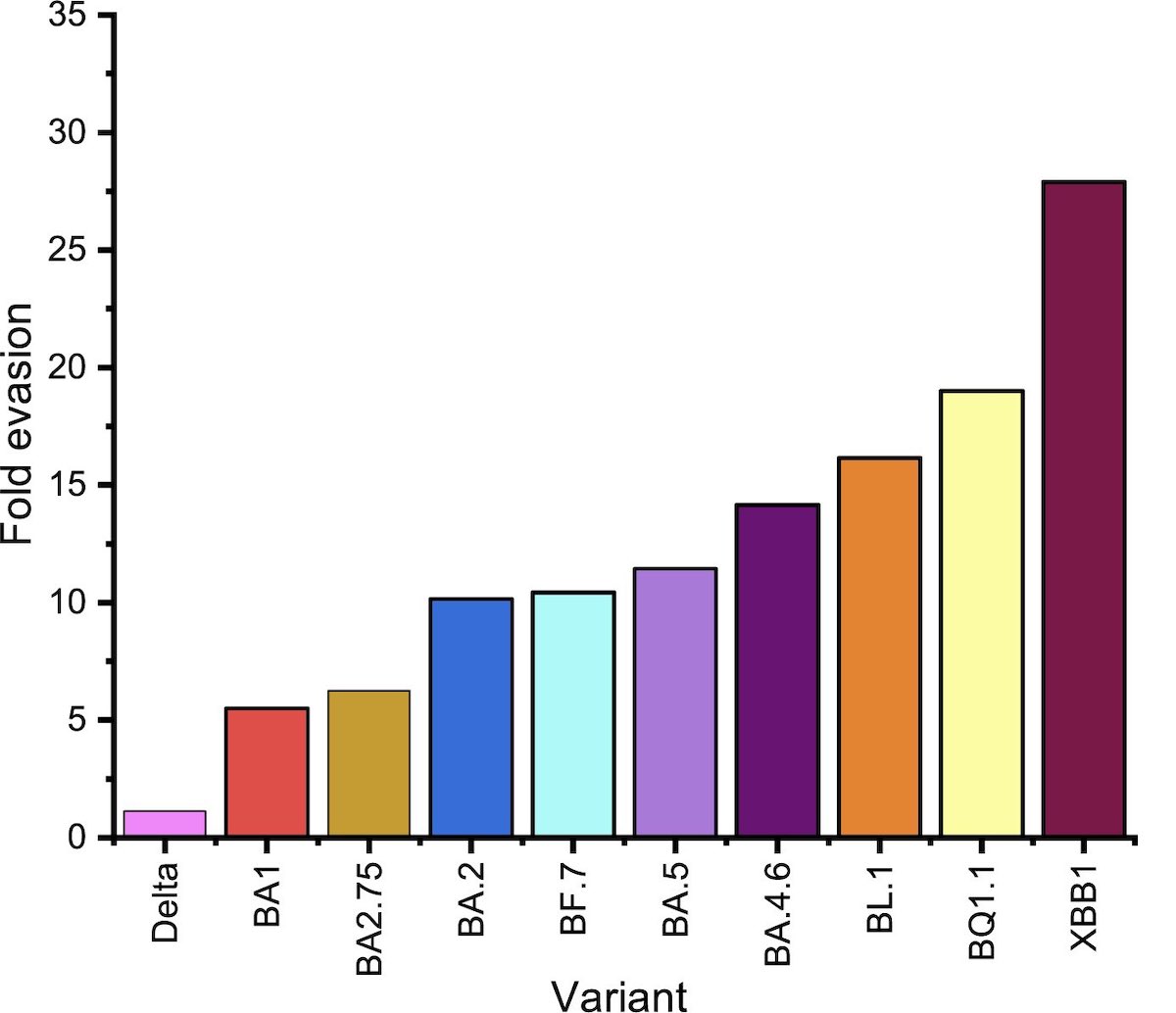
COVID Infections in U.S. Source: CDC

XBB COVID Wave in Singapore
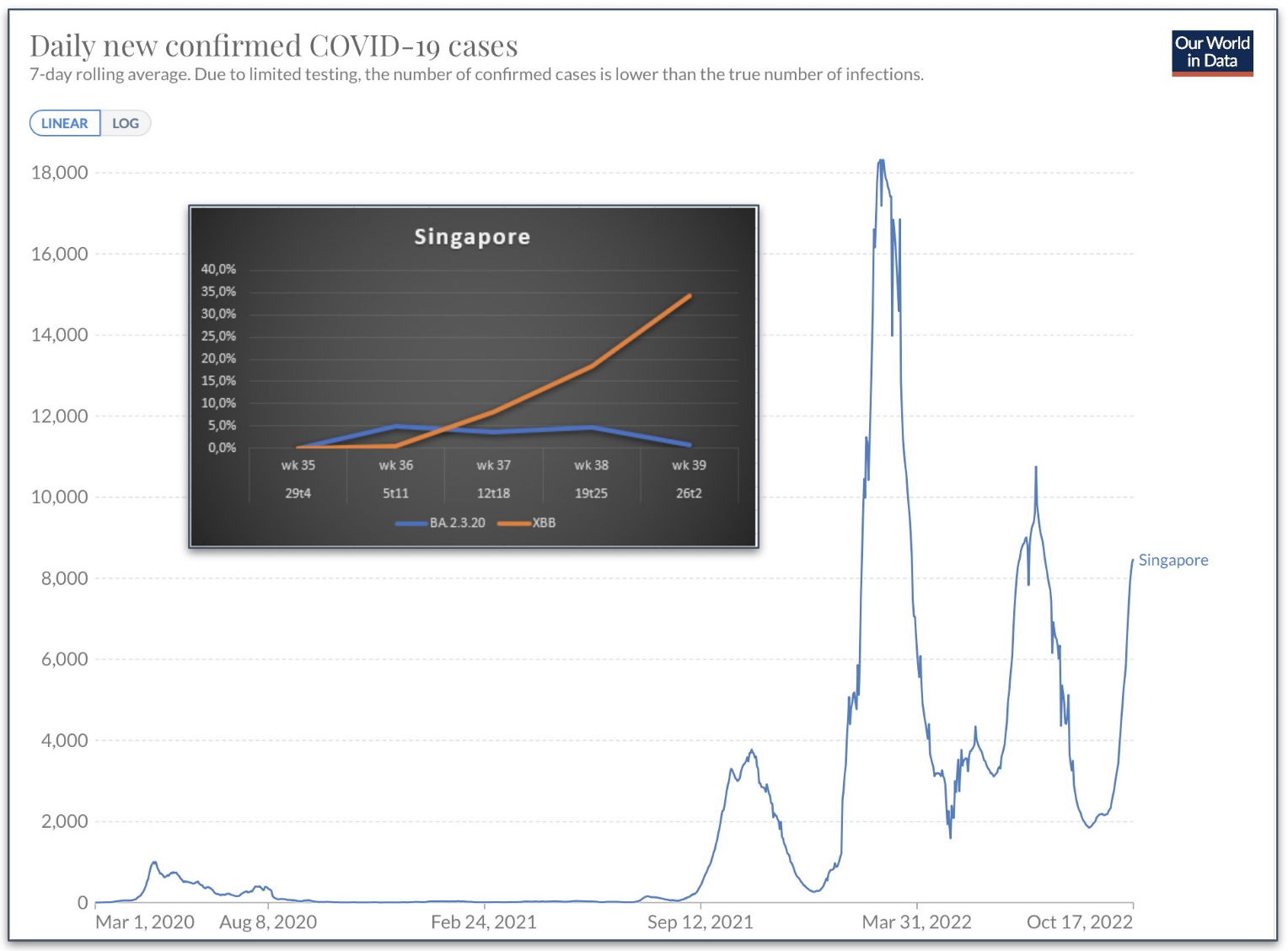
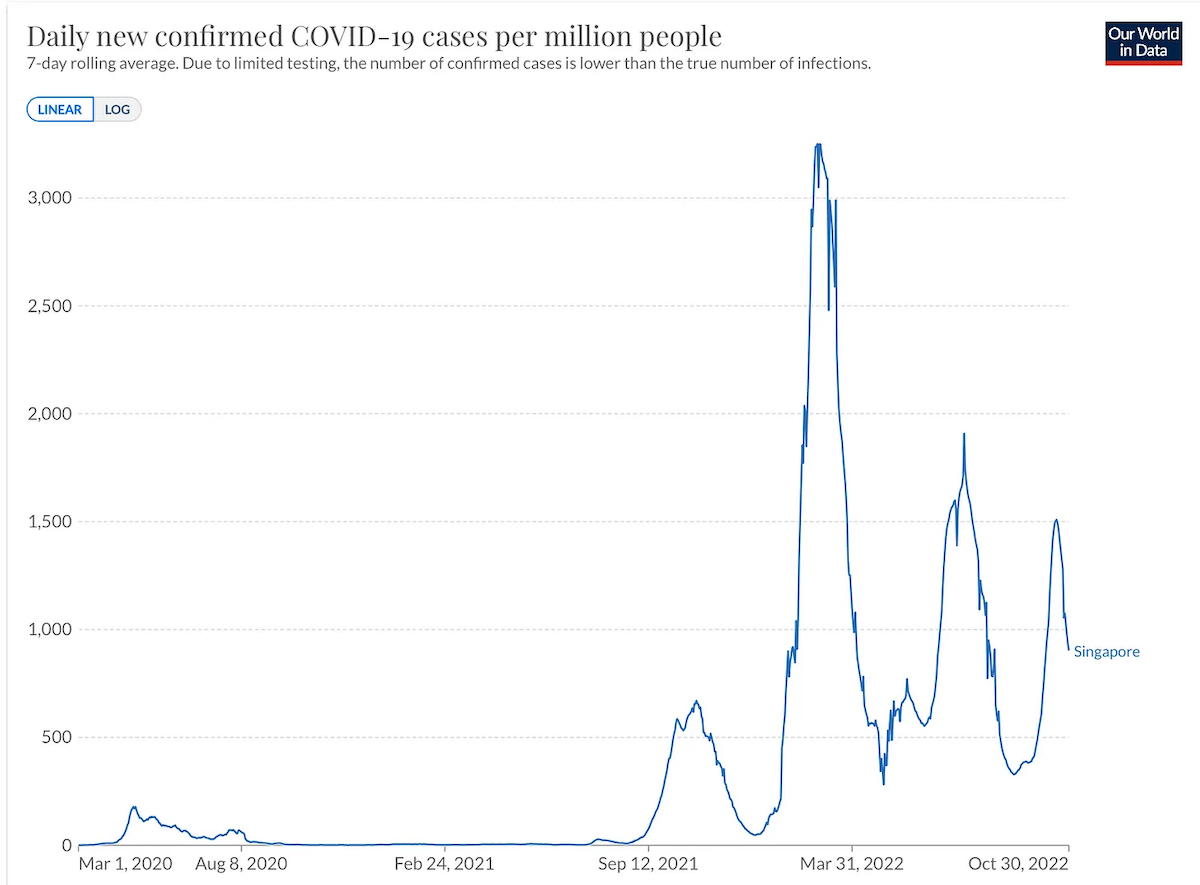
Vaccination Rate: 92% Received at least one dose ; 92% Completed full regimen ; 79% Received booster shot. MOH | Vaccination Statistics – Ministry of Health
UK Variants of Concern Report 7 October 2022
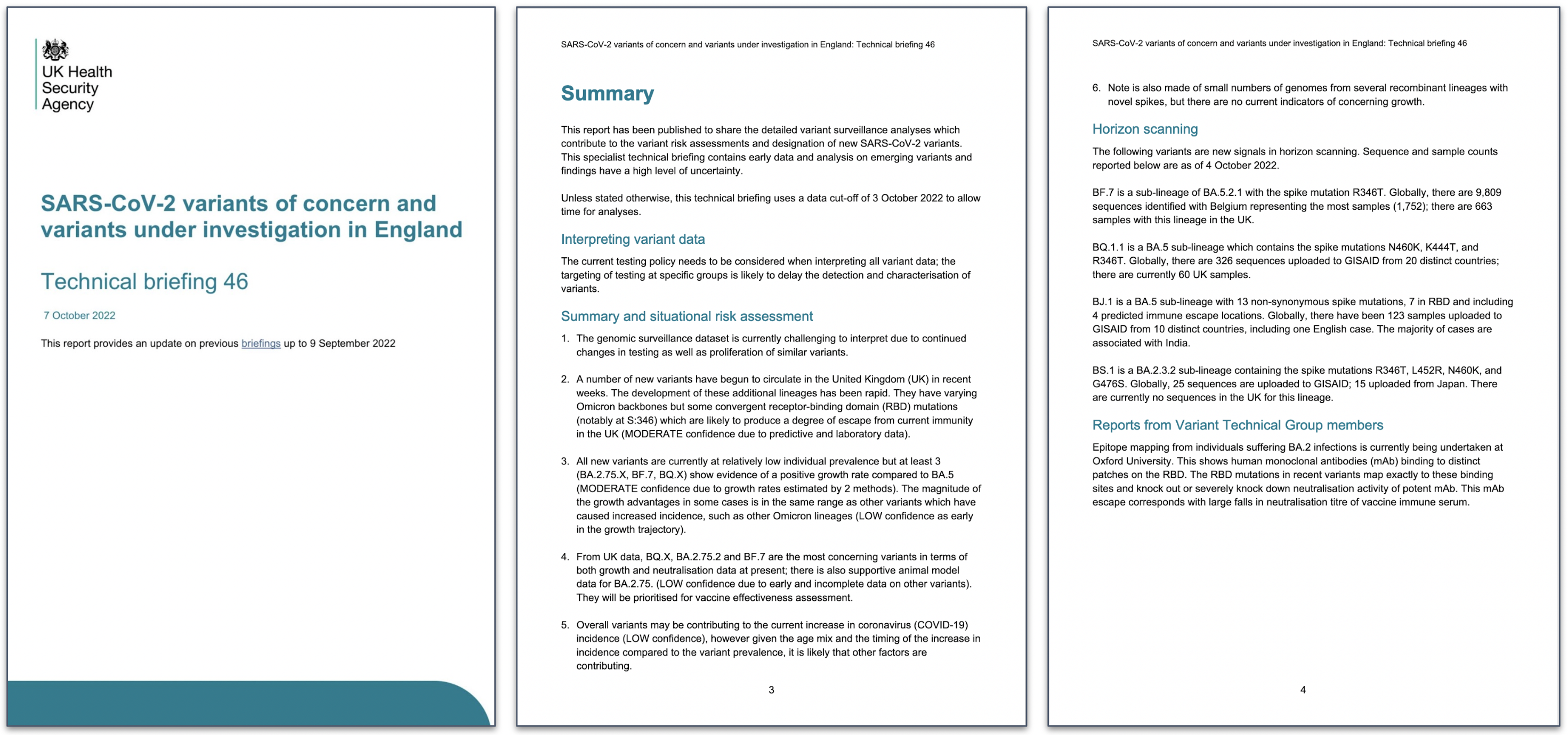
“We are seeing multiple variants with convergent evolution that will drive the next wave.” Dr. Eric Topol
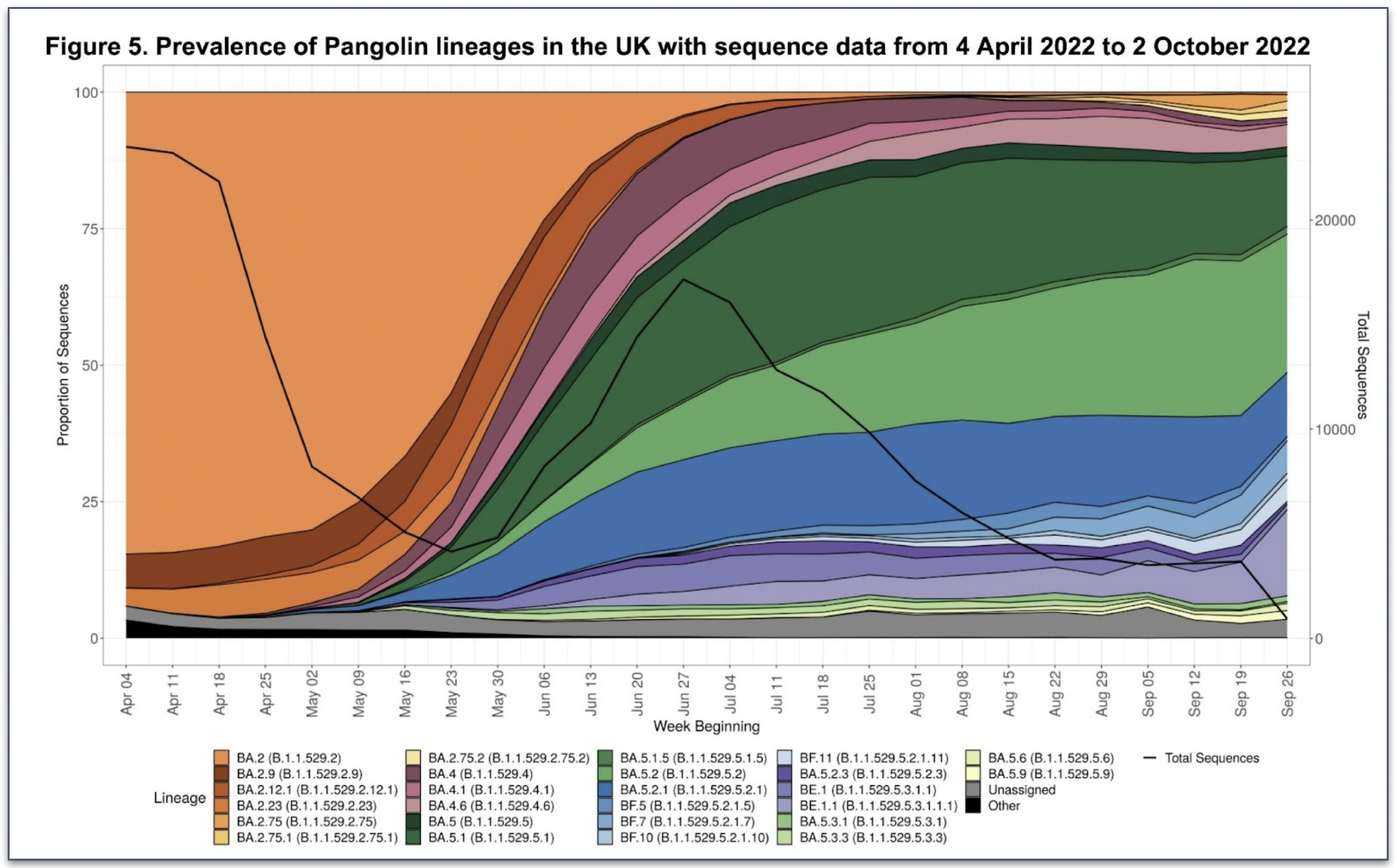
Latest XBB Variant Example. Source: Tom Peacock
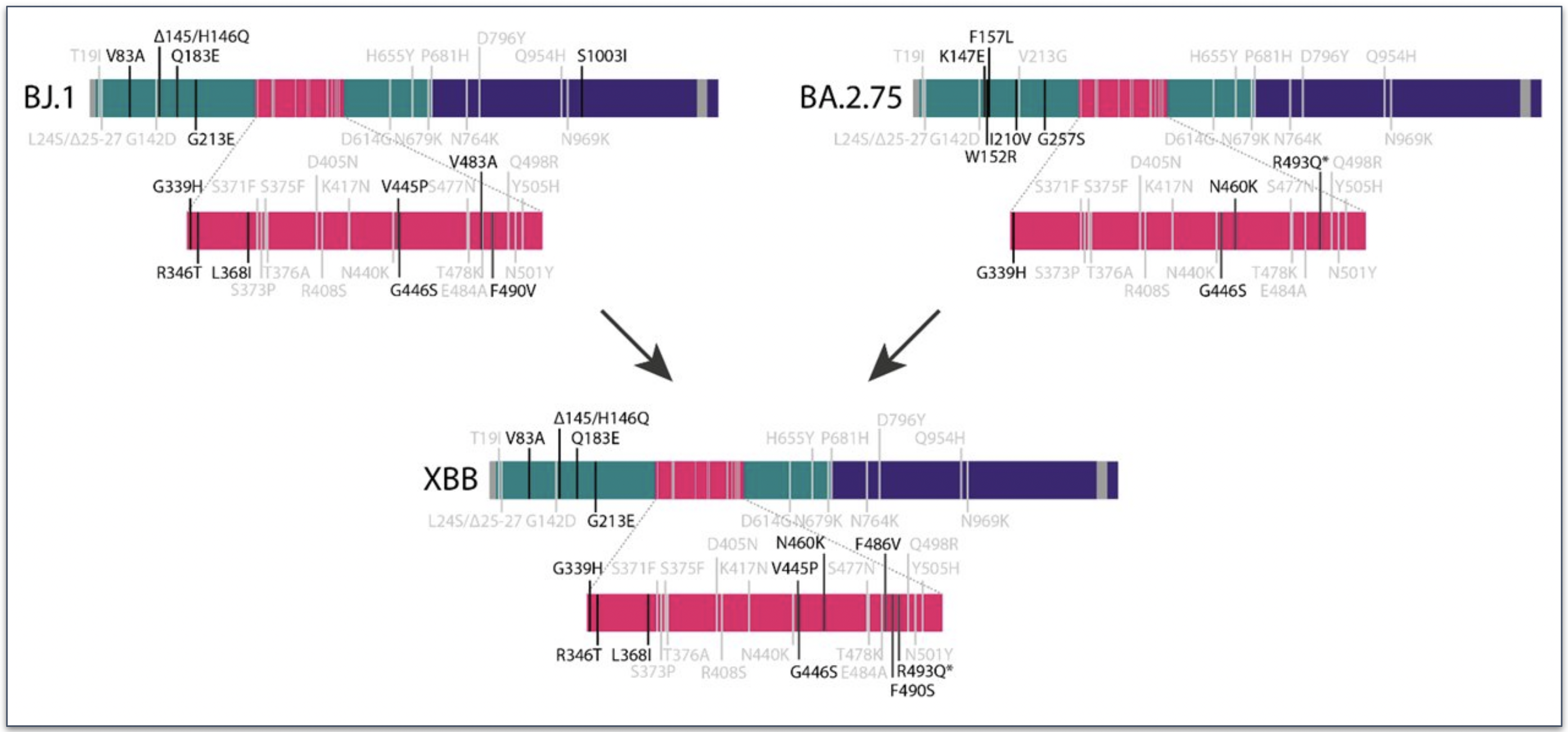
Winter 2022 COVID Wave Begins…
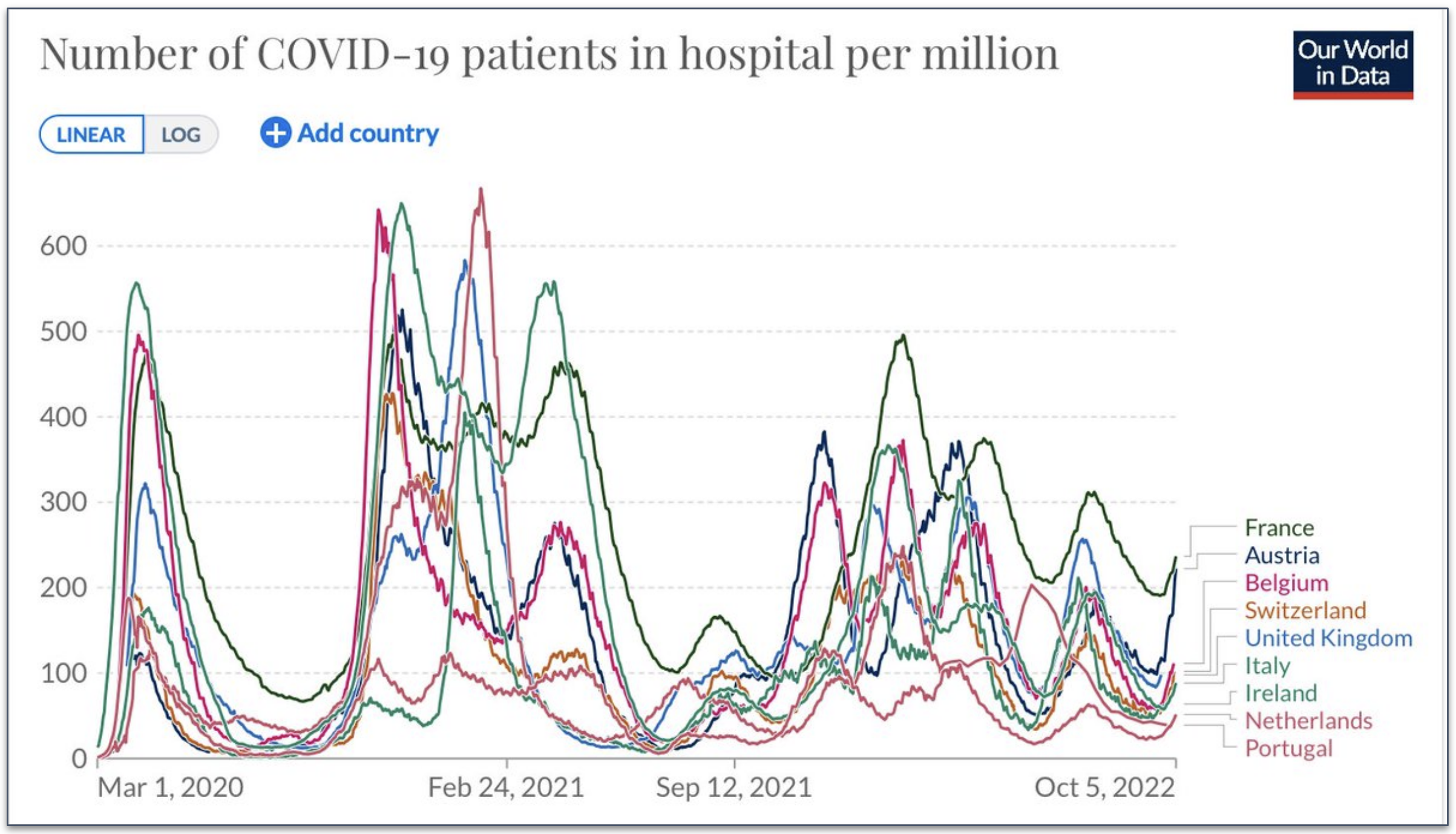
One week later…
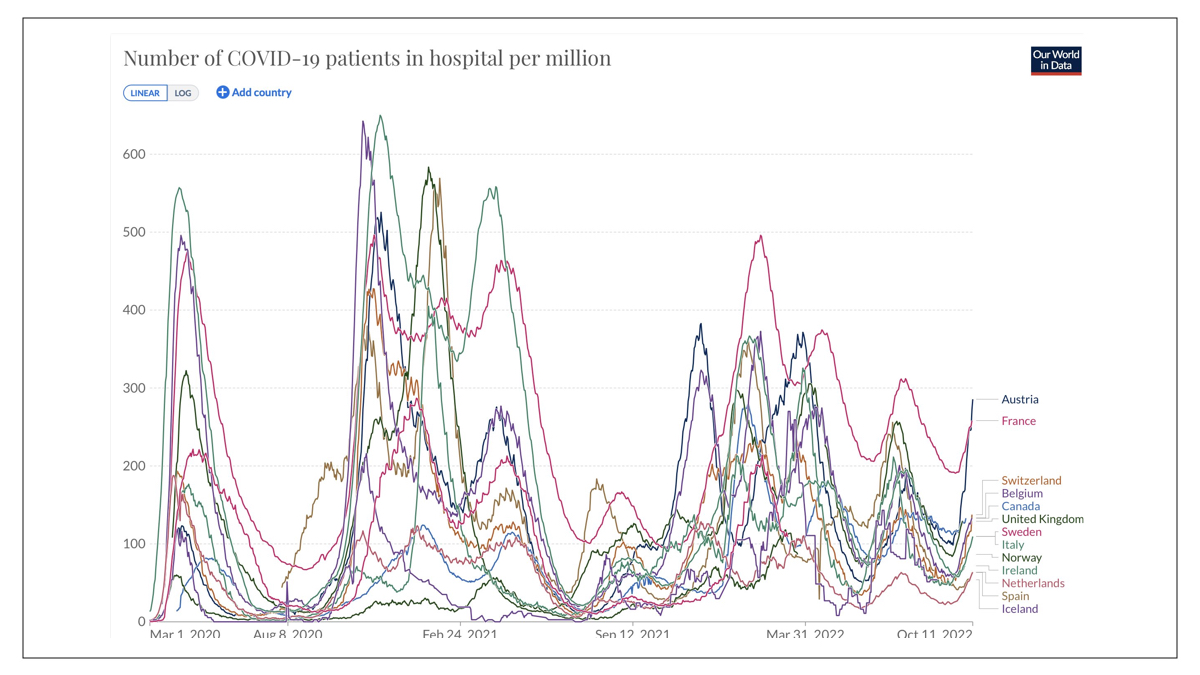
Covid-19: How to Track Viral Variants
The emergence of potentially more dangerous SARS-CoV-2 variants highlights the urgency of viral surveillance efforts.

This article appeared in print as “Surveying a Shifting Viral Landscape” in the Spring/Summer 2021 issue of Hopkins Bloomberg Public Health magazine.
This graph by @RajlabN indicates the 2 new variants with highest level of immune escape: XBB and BQ.1.1
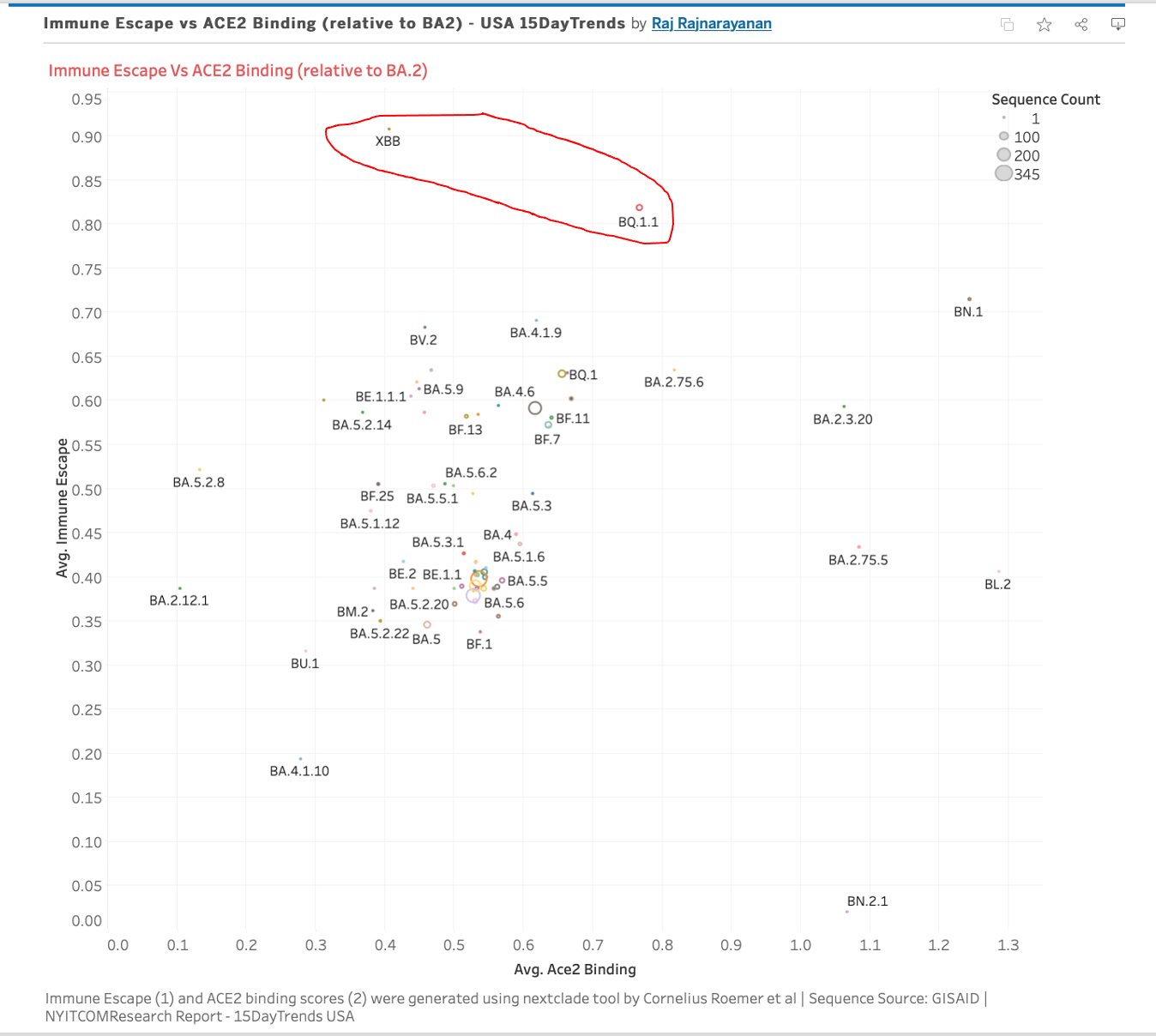
XBB and BQ.1.1, are two of the most worrisome new variants.
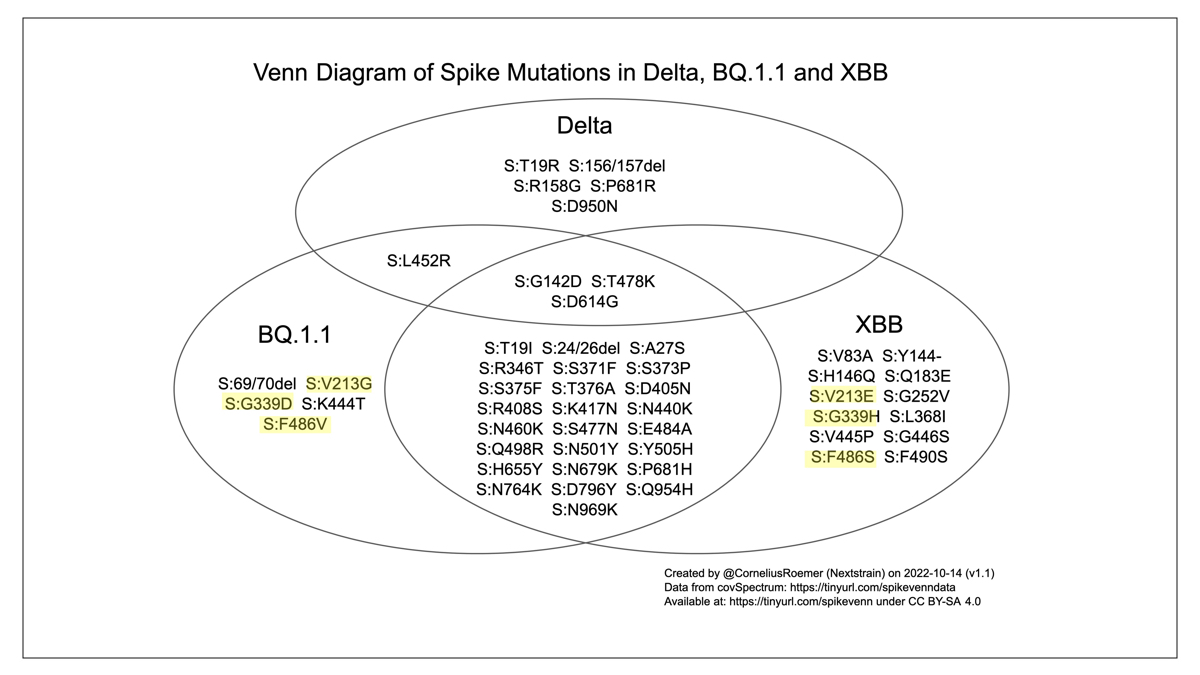
HOW SARS-COV-2 BATTLES OUR IMMUNE SYSTEM
Meet the protein arsenal wielded by the pandemic virus
Science Infographic
The Post’s View
Opinion: A new immunity-evading virus variant looms. By the Editorial Board of The Washington Post
October 25, 2022
Epidemiologist Jeremy Farrar on the Next Viral Threat “I Fear We Are at the Beginning of an Era of Pandemics”
In an interview, infectious diseases expert Sir Jeremy Farrar discusses recent mutations of the coronavirus and his worries about future pandemics. He says COVID is here to stay and that we haven’t reached a “stable phase yet” that would allow us to let down our guard. – Spiegel International
- Farrar: What we’re seeing right now is certainly not a coincidence. In 1999, it started with the Nipah virus in Malaysia. Then came SARS-1, MERS, Ebola in West Africa, Zika in Brazil, SARS-CoV-2. There are more and more people in the world, and living together in small spaces in big cities favors the spread of many viruses. And something is changing at the human-animal interface that makes it easier for viruses to jump to us. We are now 8 billion people, and we are expanding our habitat further and further into nature, and animals are migrating into cities. I fear we are at the beginning of an era of pandemics.
- DOWNLOAD FULL INTERVIEW. FOR EDUCATIONAL PURPOSES.
- Abstract Continuous evolution of Omicron has led to a rapid and simultaneous emergence of numerous variants that display growth advantages over BA.5. Despite their divergent evolutionary courses, mutations on their receptor-binding domain (RBD) converge on several hotspots. The driving force and destination of such convergent evolution and its impact on humoral immunity remain unclear. Here, we demonstrate that these convergent mutations can cause striking evasion of neutralizing antibody (NAb) drugs and convalescent plasma, including those from BA.5 breakthrough infection, while maintaining sufficient ACE2 binding capability. BQ.1.1.10, BA.4.6.3, XBB, and CH.1.1 are the most antibody-evasive strain tested, even exceeding SARS-CoV-1 level. To delineate the origin of the convergent evolution, we determined the escape mutation profiles and neutralization activity of monoclonal antibodies (mAbs) isolated from BA.2 and BA.5 breakthrough-infection convalescents. Importantly, due to humoral immune imprinting, BA.2 and especially BA.5 breakthrough infection caused significant reductions in the epitope diversity of NAbs and increased proportion of non-neutralizing mAbs, which in turn concentrated humoral immune pressure and promoted convergent evolution. Moreover, we showed that the convergent RBD mutations could be accurately inferred by integrated deep mutational scanning (DMS) profiles, and the evolution trends of BA.2.75/BA.5 subvariants could be well-simulated through constructed convergent pseudovirus mutants. Together, our results suggest current herd immunity and BA.5 vaccine boosters may not provide good protection against infection. Broad-spectrum SARS-CoV-2 vaccines and NAb drugs development should be highly prioritized, and the constructed mutants could help to examine their effectiveness in advance.


